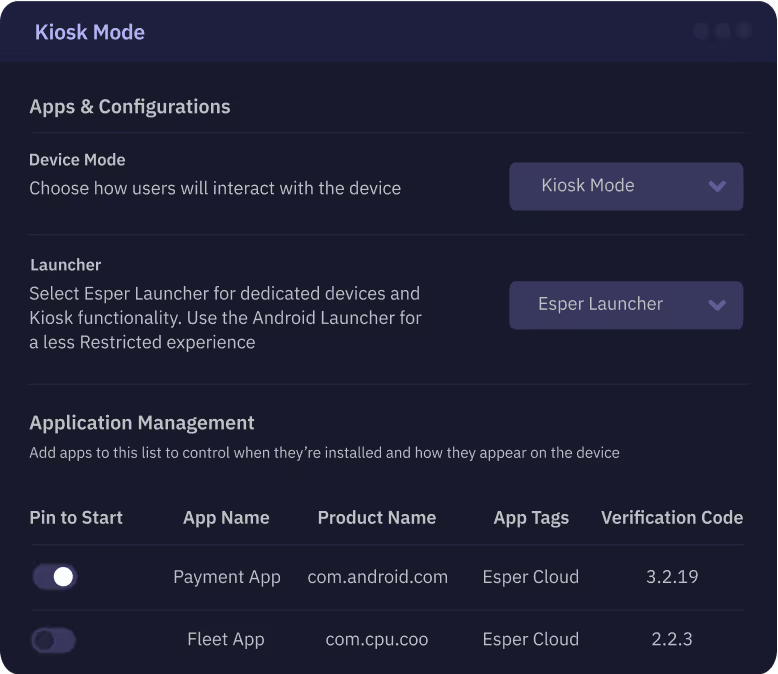
Enable maximum innovation and differentiation with the only MDM built for AOSP
Esper is the only MDM designed from the ground up for custom AOSP devices, helping you scale what you’ve worked so hard to realize. We don’t just support AOSP, we build on it — so we understand intuitively why you’ve chosen the AOSP route for your devices, and how to fully unleash their potential.

For most MDMs, AOSP support is an edge case. For Esper, it’s foundational. The enhanced customizability, configurability, and extensibility of AOSP don’t fit the “cookier-cutter” use cases these legacy tools were designed for. At Esper, we’re built different.





.avif)

Guarantee that every user has the exact experience you want — nothing more, nothing less.

Fully lock down devices to prevent misconfiguration and other tinkering that leads to costly troubleshooting and maintenance.

Limit devices to essential functions, eliminating employee distractions and customer confusion.

Shield devices from unauthorized access and modifications, keeping sensitive company data safe.

Purpose-built devices have a job to do. From point of sale systems to digital kiosks, Android to iOS, these devices are central to modern business interactions and revenue generation. When they deviate from their intended function, operations grind to a halt, causing customer frustration and lost revenue.

Don’t let an unsophisticated kiosk feature bring down your business. Esper’s hardened kiosk mode can’t be bypassed, offering robust protection for valuable hardware assets while ensuring every device in your fleet is always doing what it’s supposed to.

When you build an AOSP device, you’re choosing a commitment to control and innovation. A declaration of innovation. With Esper, you have a partner designed to support that vision — delivering enterprise-grade tools for maximum flexibility and unified management. Whether you’re scaling a mixing fleet of GMS and AOSP devices or are all-in on AOSP, Esper ensures your devices deliver consistent performance that you can manage from a single pane of glass.

Inspire Fitness achieves a full cycle go-to-market in 6 months
Inspire uses Esper’s Android expertise, both in software and devices running on Android OS, to quickly go to market and launch their connected workout experience for clients across the globe.



Parker’s Kitchen takes new Retail Program to market in 10 weeks with Esper
In only a few months, Esper delivered a turnkey Android kiosk solution for Parker’s customer loyalty program — deploying over 260 devices to Parker’s Kitchen locations, saving 60% in OpEx
.avif)


Inspire Fitness achieves a full cycle go-to-market in 6 months
Inspire uses Esper’s Android expertise, both in software and devices running on Android OS, to quickly go to market and launch their connected workout experience for clients across the globe.

.avif)
Parker’s Kitchen takes new Retail Program to market in 10 weeks with Esper
In only a few months, Esper delivered a turnkey Android kiosk solution for Parker’s customer loyalty program — deploying over 260 devices to Parker’s Kitchen locations, saving 60% in OpEx

AOSP stands for Android Open Source Project, which is an open-source initiative led by Google to develop and maintain the Android operating system.
With AOSP, you can create custom Android-based operating systems, build dedicated devices, modify the Android source code, and develop applications specifically tailored to your needs.
An AOSP build refers to a compiled version of the Android source code obtained from the AOSP repository. It includes all the necessary components and files required to run the Android operating system on a device.
AOSP is the base source code for the Android operating system, while Android refers to the complete package that includes additional components and services provided by Google, such as Google Play Services, Google apps, and proprietary features.
Yes, you can use AOSP to create your own Android-based operating system. By modifying the AOSP source code, adding or removing features, and customizing the user interface, you can create a unique version of Android tailored to your specific requirements.